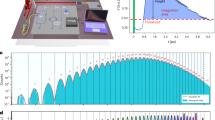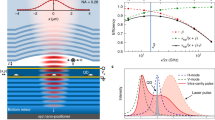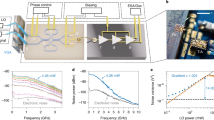Abstract
Detectors with the capability to directly measure the photon number of a pulse of light1,2,3 enable linear optics quantum computing4, affect the security of quantum communications5, and can be used to characterize6,7,8 and herald9 non-classical states of light. Here, we demonstrate the photon-number-resolving capabilities of a quantum-dot, optically gated, field-effect transistor that uses quantum dots as optically addressable floating gates in a GaAs/Al0.2Ga0.8As δ-doped field-effect transistor. When the active area of the detector is illuminated, photo-generated carriers trapped by quantum dots screen the gate field, causing a persistent change in the channel current that is proportional to the number of confined carriers. Using weak laser pulses, we show that discrete numbers of trapped carriers produce well resolved changes in the channel current. We demonstrate that for a mean photon number of 1.1, decision regions can be defined such that the field-effect transistor determines the number of detected photons with a probability of accuracy greater than 83%.
This is a preview of subscription content, access via your institution
Access options
Subscribe to this journal
Receive 12 print issues and online access
$209.00 per year
only $17.42 per issue
Buy this article
- Purchase on Springer Link
- Instant access to full article PDF
Prices may be subject to local taxes which are calculated during checkout



Similar content being viewed by others
References
Waks, E., Inoue, K., Oliver, W. D., Diamanti, E. & Yamamoto, Y. High-efficiency photon-number detection for quantum information processing. IEEE. J. Sel. Top. Quant. Electron. 9, 1502–1511 (2003).
Rosenberg, D., Lita, A. E., Miller, A. J. & Nam, S. W. Noise-free high-efficiency photon-number-resolving detectors. Phys. Rev. A 71, 61803(R) (2005).
Fujiwara, M. & Sasaki, M. Photon-number-resolving detection at a telecommunications wavelength with a charge-integration photon detector. Opt. Lett. 31, 691–693 (2006).
Knill, E., Leflamme, R. & Milburn, G. J. A scheme for efficient quantum computation with linear optics. Nature 409, 46–52 (2001).
Brassard, G., Lütkenhaus, N., Mor, T. & Sanders, B. C. Limitations on practical quantum cryptography. Phys. Rev. Lett. 85, 1330–1333 (2000).
Di Giuseppe, G. et al. Direct observation of photon pairs at a single output of a beam-splitter interferometer. Phys. Rev. A 68, 63817 (2003).
Waks, E., Diamanti, E., Sanders, B. C., Bartlett, S. D. & Yamamoto, Y. Direct observations of nonclassical photon statistics in parametric down-conversion. Phys. Rev. Lett. 92, 113602 (2004).
Waks, E., Sanders, B. C., Diamanti, E. & Yamamoto, Y. Highly nonclassical photon statistics in parametric down-conversion. Phys. Rev. A 73, 33814 (2006).
Waks, E., Diamanti, E. & Yamamoto, Y. Generation of photon number states. New J. Phys. 8, 4–8 (2006).
Yusa, G. & Sakaki, H. GaAs/n-AlGaAs field-effect transistor with embedded InAs quantum traps and its programmable threshold characteristics. Electron. Lett. 32, 491–493 (1996).
Rose, A. Concepts in Photoconductivity and Allied Problems Ch. 1 (Interscience, New York, 1963).
Rowe, M. A. et al. Single-photon detection using a quantum dot optically gated field-effect transistor with high internal quantum efficiency. Appl. Phys. Lett. 89, 253505 (2006).
Gansen, E. J. et al. Operational analysis of a quantum dot, optically gated, field-effect transistor as a single-photon detector. IEEE J. Sel. Top. Quant. Electron. (in the press).
Kardynał, B. E. et al. Photon number resolving detector based on a quantum dot field effect transistor. Appl. Phys. Lett. 90, 181114 (2007).
Kardynal, B. E. et al. Low-noise photon counting with a radio-frequency quantum-dot field-effect transistor. Appl. Phys. Lett. 84, 419–421 (2004).
Acknowledgements
This work of the US government is not subject to US copyright.
Author information
Authors and Affiliations
Corresponding author
Rights and permissions
About this article
Cite this article
Gansen, E., Rowe, M., Greene, M. et al. Photon-number-discriminating detection using a quantum-dot, optically gated, field-effect transistor. Nature Photon 1, 585–588 (2007). https://doi.org/10.1038/nphoton.2007.173
Received:
Accepted:
Published:
Issue Date:
DOI: https://doi.org/10.1038/nphoton.2007.173
This article is cited by
-
Quantum NETwork: from theory to practice
Science China Information Sciences (2023)
-
Room-temperature high sensitivity of multiple tunnel junctions based on single-charge photodetection
Journal of Computational Electronics (2019)
-
Temporal and spatial multiplexed infrared single-photon counter based on high-speed avalanche photodiode
Scientific Reports (2017)
-
Quantum dot single-photon switches of resonant tunneling current for discriminating-photon-number detection
Scientific Reports (2015)
-
Advances in InGaAs/InP single-photon detector systems for quantum communication
Light: Science & Applications (2015)



